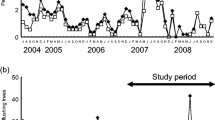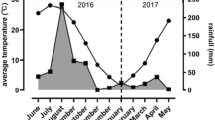Abstract
Habitat, diet and leaf chemistry are compared between Japanese and Barbary macaques to reveal the similarities and differences in dietary adaptations of temperate primates living at the eastern and western extremes of the genus Macaca. Tree species diversity and proportion of fleshy-fruited species are much higher in Japan than in North Africa. Both species spend considerable annual feeding time on leaves. Japanese macaques prefer fruits and seeds over leaves, and Barbary macaques prefer seeds. These characteristics are adaptive in temperate regions where fruit availability varies considerably with season, since animals can survive during the lean period by relying on leaf and other vegetative foods. The two species are different with respect to the higher consumption of herbs by Barbary macaques, and the leaves consumed contain high condensed and hydrolysable tannin for Barbary but not for Japanese macaques. Barbary macaques supplement less diverse tree foods with herbs. Because of the low species diversity and high tannin content of the dominant tree species, Barbary macaques may have developed the capacity to cope with tannin. This supports the idea that digestion of leaves is indispensable to survive in temperate regions where fruit and seed foods are not available for a prolonged period during each year.



Similar content being viewed by others
References
Agetsuma N (1995) Dietary selection by Yakushima macaques (Macaca fuscata yakui): the influence of food availability and temperature. Int J Primatol 16:611–627
Agetsuma N, Nakagawa N (1998) Effects of habitat differences on feeding behaviors of Japanese monkeys: comparison between Yakushima and Kinkazan. Primates 39:275–289
Ajbilou R, Maranon T, Arroyo J (2006) Ecological and biogeographical analyses of Mediterranean forests of northern Morocco. Acta Oecol 29:104–113
Ali R (1986) Feeding ecology of the bonnet macaque at the Mundanthurai Sanctuary, Tamil Nadu. J Bombay Nat Hist Soc 83:98–110
Bleisch W, Liu Z, Dierenfeld E, Xie J (1998) Selected nutrient analysis of plants in the diet of the Guizhou snub-nosed monkey (Rhinopithecus [Rhinopithecus] brelichi). In: Jablonski N (ed) The natural history of the doucs and snub-nosed monkeys. World Scientific, Singapore, pp 241–254
Burnham KP, Anderson DR (2002) Model selection and multi-model inference, 2nd edn. Springer, New York
Clutton-Brock TH (1977) Primate ecology: studies of feeding and ranging behaviour in lemurs, monkeys and apes. Academic Press, Brighton
Colwell RK, Coddington JA (1994) Estimating terrestrial biodiversity through extrapolation. Philos Trans R Soc Lond B Biol Sci 345:101–118
Curtin F, Schulz P (1998) Multiple correlations and Bonferroni’s correction. Biol Psychiatry 44:775–777
Drucker GR (1984) The feeding ecology of Barbary macaque and cedar forest conservation in the Moroccan Moyen Atlas. In: Fa JE (ed) The Barbary Macaque: a case study in conservation. Plenum, New York, pp 135–164
Fa JE (1984a) The Barbary Macaque: a case study in conservation. Plenum, New York
Fa JE (1984b) Habitat distribution and habitat preference in Barbary macaques (Macaca sylvanus). Int J Primatol 5:273–286
Fa JE (1989) The Genus Macaca: a review of taxonomy and evolution. Mammal Rev 19:45–81
Fleagle JG (1999) Primate adaptation and evolution, 2nd edn. Academic, London
Fragaszy DM, Boinski S, Whipple J (1992) Behavioral sampling in the field: comparison of individual and group sampling methods. Am J Primatol 26:259–275
Furuichi T, Hashimoto C, Tashiro Y (2001) Fruit availability and habitat use by chimpanzees in the Kalinzu Forest, Uganda: examination of fallback foods. Int J Primatol 22:929–945
Goldstein SJ, Richard AF (1989) Ecology of rhesus macaques (Macaca mulatta) in northwest Pakistan. Int J Primatol 10:531–567
Grueter CC, Li DY, Ren BP, Wei FW, Xiang ZF, van Schaik CP (2009) Fallback foods of temperate-living primates: a case study on snub-nosed monkeys. Am J Phys Anthropol 140:700–715
Hanya G (2004) Diet of a Japanese macaque troop in the coniferous forest of Yakushima. Int J Primatol 25:55–71
Hanya G, Aiba S (2010) Fruit fall in tropical and temperate forests: implications for frugivore diversity. Ecol Res 25:1081–1090
Hanya G, Yamada H, Arakane T (2002) Expeditionary ranging by a Japanese macaque troop in Hieizan. Anthropol Sci 110:415–420
Hanya G, Noma N, Agetsuma N (2003) Altitudinal and seasonal variations in the diet of Japanese macaques in Yakushima. Primates 44:51–59
Hanya G, Yoshihiro S, Zamma K, Matsubara H, Ohtake M, Kubo R, Noma N, Agetsuma N, Takahata Y (2004) Environmental determinants of the altitudinal variations in relative group densities of Japanese macaques on Yakushima. Ecol Res 19:485–493
Hanya G, Kiyono M, Takafumi H, Tsujino R, Agetsuma N (2007) Mature leaf selection of Japanese macaques: effects of availability and chemical content. J Zool 273:140–147
Hasegawa K (1993) Nutritional analysis (in Japanese). Baifukan, Tokyo
Hemingway C, Bynum N (2005) The influence of seasonality on primate diet and ranging. In: Brockman DK, van Schaik CP (eds) Seasonality in primates: studies of living and extinct human and non-human primates. Cambridge University Press, Cambridge, pp 57–104
Herrera CM (1984) A study of avian frugivores, bird-dispersed plants, and their interaction in Mediterranean scrublands. Ecol Monogr 54:1–23
Hill DA (1997) Seasonal variation in the feeding behavior and diet of Japanese macaques (Macaca fuscata yakui) in lowland forest of Yakushima. Am J Primatol 43:305–322
Iwamoto T (1982) Food and nutritional condition of free ranging Japanese monkeys on Koshima Islet during winter Primates 23:153–170
Izumiyama S (2002) Above the forest limit (in Japanese). In: Oi T, Masui K (eds) Natural history of Japanese macaque: their ecological diversity and conservation. Tokai University Press, Tokyo, pp 67–77
Janson C, Chapman C (1999) Resources and primate community structure. In: Fleagle J, Janson C, Reed K (eds) Primate communities. Cambridge Univ Press, Cambridge, pp 237–267
Kirkpatrick RC (1999) Colobine diet and social organization. In: Dolhinow P, Fuentes A (eds) The nonhuman primates. Mayfield, Mountain View, pp 93–105
Kirkpatrick RC, Zou RJ, Dierenfeld ES, Zhou HW (2001) Digestion of selected foods by Yunnan snub-nosed monkey Rhinopithecus bieti (Colobinae). Am J Phys Anthropol 114:156–162
Knott CD (1998) Changes in orangutan caloric intake, energy balance, and ketones in response to fluctuating fruit availability. Int J Primatol 19:1061–1079
Komiyama A, Kato S, Teranishi M (2001) Differential overstory leaf flushing contributes to the formation of a patchy understory. J For Res 6:163–171
Kurita H, Shiniomura T, Fujita T (2002) Temporal variation in Japanese macaque bodily mass. Int J Primatol 23:411–428
Lambert JE (1998) Primate digestion: interactions among anatomy, physiology, and feeding ecology. Evol Anthropol 7:8–20
Marshall AJ, Wrangham RW (2007) Evolutionary consequences of fallback foods. Int J Primatol 28:1218–1235
Mehlman PT (1988) Food resources of the wild barbary macaque (Macaca sylvanus) in high altitude fir forest, Ghomaran Rif, Morocco. J Zool 214:469–490
Ménard N (1985) Le régime alimentaire de Macaca sylvanus dans différents habitats d’Algérie: I. Régime en chênaie décidue. Revue d’Ecologie (La Terre Et La Vie) 40:351–466
Ménard N (2002) Ecological plasticity of Barbary macaques (Macaca sylvanus). Evol Anthropol 11:95–100
Ménard N, Qarro M (1999) Bark stripping and water availability: a comparative study between Moroccan and Algerian Barbary Macaques (Macaca sylvanus). Revue d’Ecologie (La Terre Et La Vie) 54:123–132
Ménard N, Vallet D (1986) Le régime alimentaire de Macaca sylvanus dans différents habitats d’Algérie: II. Régime en forêt sempervirente et sur les sommets roucheux. Revue d’Ecologie (La Terre Et La Vie) 41:173–192
Ménard N, Vallet D (1988) Disponibilités et utilisation des ressources par le magot (Macaca sylvanus) dans différents milieux en Algérie. Revue d’Ecologie (La Terre Et La Vie) 43:201–250
Muroyama Y, Kanamori H, Kitahara E (2006) Seasonal variation and sex differences in the nutritional status in two local populations of wild Japanese macaques. Primates 47:355–364
O’Brien TG, Kinnaird MF (1997) Behavior, diet, and movements of the Sulawesi crested black macaque (Macaca nigra). Int J Primatol 18:321–351
Pond CM (1978) Morphological aspects and ecological and mechanical consequences of fat deposition in wild vertebrates. Annu Rev Ecol Syst 9:519–570
Porter LJ (1989) Tannins. In: Dey PM, Harborne JB (eds) Methods in plant biochemistry, vol 1. Plant phenolics. Academic, London, pp 389–419
Rautio P, Bergvall UA, Karonen M, Salminen JP (2007) Bitter problems in ecological feeding experiments: commercial tannin preparations and common methods for tannin quantifications. Biochem Syst Ecol 35:257–262
Sakai S (2002) General flowering in lowland mixed dipterocarp forests of South-east Asia. Biol J Linn Soc 75:233–247
Skopec MM, Haley S, Torregrossa AM, Dearing MD (2008) An oak (Quercus agrifolia) specialist (Neotoma macrotis) and a sympatric generalist (Neotoma lepida) show similar intakes and digestibilities of oak. Physiol Biochem Zool 81:426–433
Su HH, Lee LL (2001) Food habits of Formosan rock macaques (Macaca cyclopis) in Jentse, northeastern Taiwan, assessed by fecal analysis and behavioral observation. Int J Primatol 22:359–377
Suzuki A (1965) An ecological study of wild Japanese monkeys in snowy areas: focused on their food habits. Primates 6:31–72
Terborgh J (1983) Five New World primates. Princeton University Press, Princeton
Ting S, Hartley S, Burns KC (2008) Global patterns in fruiting seasons. Glob Ecol Biogeogr 17:648–657
Tsuji Y, Takatsuki S (2004) Food habits and home range use of Japanese macaques on an island inhabited by deer. Ecol Res 19:381–388
Tsuji Y, Fujita S, Sugiura H, Saito C, Takatsuki S (2006) Long-term variation in fruiting and the food habits of wild Japanese macaques on Kinkazan Island, northern Japan. Am J Primatol 68:1068–1080
van Schaik CP, Pfannes K (2005) Tropical climates and phenology: a primate perspective. In: Brockman DK, van Schaik CP (eds) Seasonality in primates: studies of living and extinct human and non-human primates. Cambridge University Press, Cambridge, pp 23–54
van Schaik CP, Terborgh JW, Wright SJ (1993) The phenology of tropical forests: adaptive significance and consequences for primary consumers. Annu Rev Ecol Syst 24:353–377
van Soest PJ, Robertson JB, Lewis BA (1991) Methods for dietary fiber, neutral detergent fiber, and nonstarch polysaccharides in relation to animal nutrition. J Dairy Sci 74:3583–3597
Wada K (1975) Ecology of wintering among Japanese monkeys in Shiga heights and its adaptive significance. Physiol Ecol Jpn 16:9–14
Waterman P (1984) Food acquisition and processing as a function of plant chemistry. In: Chivers DJ, Wood BA, Bilsborough A (eds) Food acquisition and processing in primates. Plenum, New York, pp 177–211
Willis RB, Allen PR (1998) Improved method for measuring hydrolyzable tannins using potassium iodide. Analyst 123:435–439
Willson MF, Irvine AK, Walsh NG (1989) Vertebrate dispersal syndromes in some Australian and New Zealand plant communities, with geographic comparisons. Biotropica 21:133–147
Yamagiwa J, Hill D (1998) Intraspecific variation in the social organization of Japanese macaques: past and present scope of field studies in natural habitats. Primates 39:257–273
Yeager CP (1996) Feeding ecology of the long-tailed macaque (Macaca fascicularis) in Kalimantan Tengah, Indonesia. Int J Primatol 17:51–62
Acknowledgments
We would like to thank our friends and colleagues who supported our fieldwork in Japan, Morocco and Algeria. The Ministry of Environment and Forestry Agency, Japan, and Haut Commissariat aux Eaux et Forêt et à la Lutte Contre la Désertification, Morocco gave us permission to study in the area. Dr. Y. Tsuji kindly provided his published data. This study was financed by the JSPS Core-to-core Program HOPE, Cooperation Research Program of KUPRI and the MEXT Grant-in-Aid for JSPS Fellows, Grant-in-Aid for Young Scientists (#20770195 and #22687002) to G.H., the 21st Century COE Program (A14) and Global COE Program “Formation of a Strategic Base for Biodiversity and Evolutionary Research: from Genome to Ecosystem”.
Author information
Authors and Affiliations
Corresponding author
About this article
Cite this article
Hanya, G., Ménard, N., Qarro, M. et al. Dietary adaptations of temperate primates: comparisons of Japanese and Barbary macaques. Primates 52, 187–198 (2011). https://doi.org/10.1007/s10329-011-0239-5
Received:
Accepted:
Published:
Issue Date:
DOI: https://doi.org/10.1007/s10329-011-0239-5




